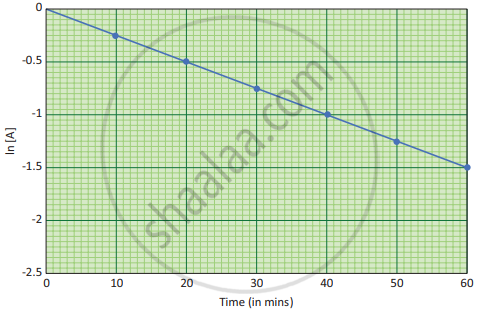Advertisements
Advertisements
प्रश्न
Describe the graphical representation of first order reaction.
उत्तर
Rate constant for first order reaction is,
kt = ln `((["A"_0])/(["A"]))`
kt = In [A0] – In [A]
In [A] = In [A0] – kt
y = c + mx
If we follow the reaction by measuring the concentration of the reactants at regular time intervals ‘t’, a plot of ln [A] against ‘t’ yields a straight line with a negative slope. From this, the rate constant is calculated.

A plot of ln [A] Vs t for a first order reaction, \[\ce{A -> product}\] with initial concentration of [A] = 1.00 M and k = 2.5 × 10−2 min−1
APPEARS IN
संबंधित प्रश्न
Solve
In a first-order reaction, the concentration of the reactant decreases from 20 mmol dm-3 to 8 mmol dm-3 in 38 minutes. What is the half-life of reaction?
Give two examples for zero order reaction.
A first order reaction is 40% complete in 50 minutes. Calculate the value of the rate constant. In what time will the reaction be 80% complete?
A reaction that is of the first order with respect to reactant A has a rate constant 6 min−1. If we start with [A]0 = 0.5 mol dm−3, when would [A] reach the value 0.05 mol dm−3?
The rate constant of a reaction has same units as the rate of reaction. The reaction is of ____________.
The rate and the rate constants of the reaction, \[\ce{A + 2B -> C + D}\] are 8 × 10−3 mol dm−3 s−1 and 2 × 10−3 s−1 respectively. The concentrations of A and B are 4 mol dm−3 each. The overall order of the reaction is ____________.
A first order reaction is 75% completed in 60 minutes, the time required for it's 50% completion is ____________.
The expression to calculate time required for completion of zero order reaction is ______.
The integrated rate law is a direct relationship between time and ______
Which of the following is correct for a first-order reaction?
